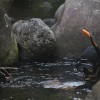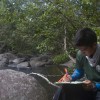Getting from Valor in the Pacific in Oahu to Kalaupapa National Historical Park in Molokai was probably the easiest transit from park to park I’ve had yet! The two islands are only 30 minutes away by air, so with a quick taxi ride to the airport I was on my way to Kalaupapa. The airline was a private charter service, and I got to sit in the cockpit! I’m still very much a child at heart, so it was incredibly exciting.
Once I arrived I met with Eric Brown, the marine ecologist at Kalaupapa and Sly Lee, a marine biological science technician in the park. After a quick tour of the office, Sly took some NOAA researchers and me on a tour of the park. We saw the original settlement, the church where Father Damien preached, the world’s tallest sea cliffs, and the original and still functioning lighthouse. Majestic can’t even begin to describe the natural beauty of the park.
Sly also gave me some background on the park’s history. The settlement was established in the late 1800s as a colony for those with Hansen’s Disease, or leprosy. Native Hawaiians on the peninsula were displaced as the government began the forced exile of those afflicted with leprosy to Kalaupapa, tearing them away from their homes and forcing them into colonies of isolation. This isolation continued until the 1940s, when a cure for leprosy was found, and the government began to ease the isolationist policies. In 1980 Kalaupapa National Historical Park was created to preserve the history of the settlement, and maintain the home of the remaining patients. Today the park is a quiet haven to protect the biological and cultural resources. More importantly, the park also exists to protect and preserve the memories of the patients, who are the last survivors of this terrible legacy.
After I got acquainted with the resources on land, it was time to explore the resources underwater! I quickly put together my underwater camera setup, and enjoyed the unbelievably crystal-clear waters of Kalaupapa. This was my first experience in warm Pacific waters, and I was loving every moment.
My first day in Kalaupapa concluded with community volleyball, a wonderful tradition that happens every Wednesday and Saturday evening. My volleyball skills (or lack thereof) were quite embarrassing, but everyone was encouraging and there to have a good time, regardless of skill level. It was a great way to meet some of the settlement’s 90 residents!
The work week started with the arrival of two University of Hawaii at Hilo researchers, Lindsey Kramer and Kerrie Krosky. Their research involved assessing algae growth and the impact of algal predation from different kinds of marine organisms. The data and research also assessed algal growth on a larger scale in relation to location and causes, such as nutrient runoff from agriculture. I was very impressed by the scope of the research, as well as its implications. For their work here in Kalaupapa we were diving on fixed sites and meticulously collecting algae using an underwater vacuum. Each dive was almost two hours long and required constant attention and concentration, but it was a great challenge to test my scientific diving skills.
Eric (left) and Lindsey collect algae on a fixed site in Kalaupapa.

Luckily diving wasn’t all work and no play- I had a delicious coconut break after a long day of diving! Kalaupapa is home to countless coconut palm trees, as well as mango, banana, papaya, mountain apple, lemon and avocado trees, to name a few. Each day usually featured a healthy and delicious snack break!
Halfway through the week Lindsey, Kerrie, Sly and I joined Carrie Mardorf, the Cultural Resources Program Manager at the park to photograph the Supermoon. We watched the moon rise over the sea cliffs and reflect over the waves. Witnessing special events in nature such as this definitely reminds me how lucky I am!
At the end of the week I joined Eric on a monk seal survey, which involved two hours of hiking along the rocky shoreline to observe and record monk seal activity. Monk seals are an endangered species, and the long-term monitoring helps determine habitat preference and seasonal preference over time in Kalaupapa. Our first hour of hiking yielded no monk seal sightings, but luckily during the second hour we saw two adults and a mother and pup seal! I had observed pinnipeds in the Channel Islands, but this experience impressed upon me the need for research, to preserve pupping areas.
After another rousing game of volleyball on Saturday, the next week began by preparing for a five-day camping expedition to Waikolu Valley to perform stream surveys. Eric, Sly, Randall Watanuki, the park’s maintenance mechanic and boat operator and I were joined by Dave Raikow, an Ecologist with the Pacific Island Network Inventory and Monitoring National Park Service, and Anne Farahi, a Biological Science Technician with the same organization. Our mission for the week was to collect water quality samples, perform fish and snail surveys and monitor the current at fixed and temporary stream sites throughout the valley. This was a great opportunity for me to gain experience in terrestrial research!
- Anne performs a fish survey in the stream
- Sly records water quality data
- Dave and I measure stream velocity
Each morning would begin with a briefing on the day’s activities, and then we would begin our hike to the first site of the day. Our route took us through a tropical forest, and the first few days involved bushwhacking our way through the dense clusters of guava, coffee and kukui nut trees. Each morning was a sensory experience as we fought off prickly lantana bushes, inhaled the sour-sweet smell of overripe guava and heard the occasional squeal of a wild pig in the distance. The days were long and physically exhausting, but the view on returning to our campsite each evening never failed to inspire me.
After our week in Waikolu was over we said farewell to Dave and Anne, and Sly and I went on some photo dives to practice our 3D modeling. I had produced a few models in Pearl Harbor, but was eager to try my hand at modeling corals. Sly gave me some tips on my modeling techniques, and I soon I was cranking out some pretty sweet models! The blend of underwater photography and 3D technology was incredibly appealing to my interests, and I loved learning a new technology. What can I say, I’m a nerd! Click here to check out one of the 3D models.
Another unique experience I had in Kalaupapa was shopping for groceries. Now, that may not sound very exciting, but the nearest grocery store for non-residents is actually on topside Molokai, which is a 3 mile hike up 1,700 feet in elevation. I’m glad I had some practice with hiking while in Waikolu Valley, because it was a tough trek! Not to mention the added weight of groceries on the way down. Still, I’m glad I did the hike if only to say that I had to hike 3 miles up to get groceries!
The view of the peninsula from halfway up the trail.
My third and final week in Kalaupapa was spent diving with Eric, Randall and Sly to pick up coral settlement tiles at various fixed sites around the peninsula. Diving all around the park was a great way to familiarize myself with Pacific diving and see different coral species. There were beautiful hard coral specimens, and I was reminded of the incredible biological resources of the park.

I spent my last few days in Kalaupapa enjoying the beauty of the park and it’s people. I joined Sly and a couple of his friends visiting the park on a salt collection expedition. We walked around the craggy shoreline searching for saltwater ponds that had dried out. We found a couple good-sized ponds, and I collected enough salt for a small souvenir!
My last evening in the park coincided with a volleyball night; there were twice as many people as usual, and I managed to score the winning goal of the last game! After the game we all hung out next door and enjoyed a true Hawaiian luau: great food, live ukelele music and singing. A perfect end to a perfect park visit!















You hit another one ‘out of the park’ to make this a clean sweep, Yasmeen. Congratulations! You produced a great series on your review of ocean parks. What will you do for an encore? Perhaps a session at the George Wright Society Conference in Oakland, CA, March 29-Aoril 2, 2015?
Yasmeen is coming here to DC in a couple of weeks to meet with NPS Washington Office leadership and tell her story. Just as the parks look forward to hosting the OWUSS-NPS intern, it’s become an annual event here, too.